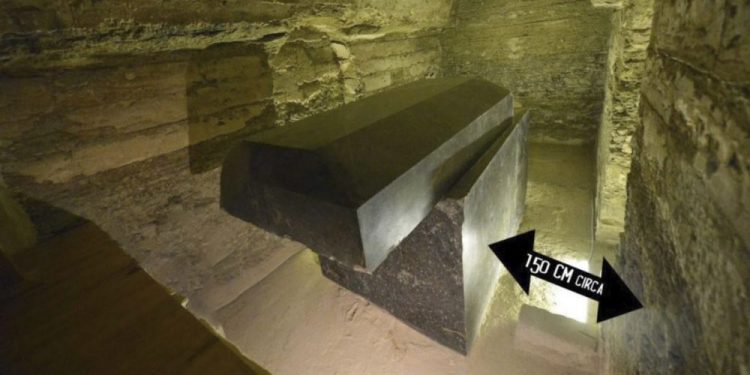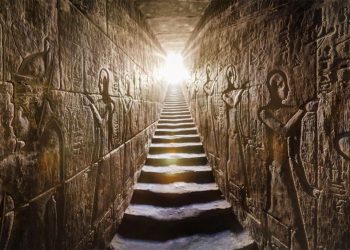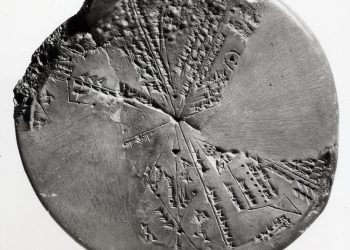The Serapeum of Saqqara has remained a mystery since its re-discovery in 1850. It is the cemetery of the personified ancient Egyptian Apis bulls, the god Ptah. A graveyard near Memphis, the Serapeum is located to the Northwest of the pyramid of Djoser at Saqqara.
Below are ten things you should know about the Serapeum of Saqqara and the sacred Apis bulls.
Saqqara is an extensive ancient Egyptian burial ground located close to the entrance of the Nile Delta. Evidence of constructions at the royal necropolis date back to the 1st dynasty when the sepulcher was on the ridge of the desert plateau, west of the new Memphis capital. Saqqara is home to the Step Pyramid of Djoser, Egypt’s first stone pyramid, and various other ancient Egyptian tombs.
Although not located near the Giza pyramids, on a bright day and weather permitting, the Step pyramid of Netjerikhet (Djoser) becomes visible from Giza, located 10km and 17km to the south and north of Dashur, respectively. In addition to the Step Pyramid of Djoser and various other monuments, Saqqara is known for the Serapeum of Saqqara, a burial place of Apis bulls, the sacred ancient Egyptian bulls.
As the largest part of the Memphis necropolis, Saqqara is significant and borders Dashur to the south, which was presumably an extension to the royal necropolis of Saqqara. Throughout the first 3000 years of its advancement, Saqqara spread to cover 6km from the north to south and 1.5km from east to west. In addition, Dahshur is home to two significant ancient Egyptian pyramids; the Bent pyramid and the Red Pyramid, which are believed to have laid down the foundations for constructing the Great Pyramid.
Many ancient tombs are thought to have been built at Saqqara, but some of the most prominent among these sepulchers are those of Teti, Unas, and Netjerikhet, respectively. Saqqara was popular as a burial place in the 1st intermediate period, the middle kingdom, and the second intermediate period before Memphis assumed its relevance. The Northern cemetery extended beyond the ancient tombs built at Saqqara plateau’s border in the first dynasty.
Some of these mastabas are thought to date back to the 5th and 6th dynasties. Therefore, it is believed that Giza was the principal burial ground in the 4th dynasty. The Netjerkhet burial place is to the north and west of the Djoser complex, the 3rd dynasty tombs’ location. It’s also where the mastaba of the 5th dynasty Ptahhotep was located.
Among the Bovine deities in ancient Egypt, Apis was the most significant. It represented influence, power, and cultural significance. Egyptians called the ceremony of the Apis bull “The Running of Apis.” The worship of the Api bull dated to the first dynasty between 3150 to 2890 BCE.
Apis appeared in Egyptian history as a striding bull adorned with a sacred serpent, symbolizing the king’s power and the solar disc between its horns. Apis depicted a man with a bull’s head in the late period of ancient Egypt, while Roman-Egypt made it the populous image of god. In the Ptolemaic period, it became the bearded man in robes, just like the Greek god Zeus.
The origin of Apis was not mythological but proven through engravings from the Pre-dynastic period dating from 6000 to 3150 BCE. Ancient Egyptians concretized Apis status as a god of fertility and primal power associated with god Ptah’s creation. This is dated to the early Egyptian dynastic period from 3150 to 2613.
People came from all over the city of Egypt to worship the Apis. The priests would let Apis roam in a special chamber during special feasts and festivals. With foodstuff and symbols at different chamber gates, people would make consultations about the future and ask general questions.
Priests often kill the Apis bull after 25 years if the animals did not die of disease or natural cause. The people would eat the deceased animals’ meat and take part in the Memphis temple for embalmment. Afterward, they would mourn the embalmed god, after which they take the mummified bull to the Royal Necropolis of Saqqara for burial inside the Serapeum. Ancient Egypt believed that every aspect of life was sacred and an extension of the divine. The death of Apis bulls was merely a transition to a new state.
The Persians under Cambyses II attacked Egypt in 525 BCE. Herodotus reported that Cambyses II killed the Apis bull at the battle of Pelusium before its time and flung the carcass into the street. Cambyses II later paid for his crime by stabbing himself in the thigh, at the same spot he had pierced the bull and died from an infection.
Join the discussion and participate in awesome giveaways in our mobile Telegram group. Join Curiosmos on Telegram Today. t.me/Curiosmos











